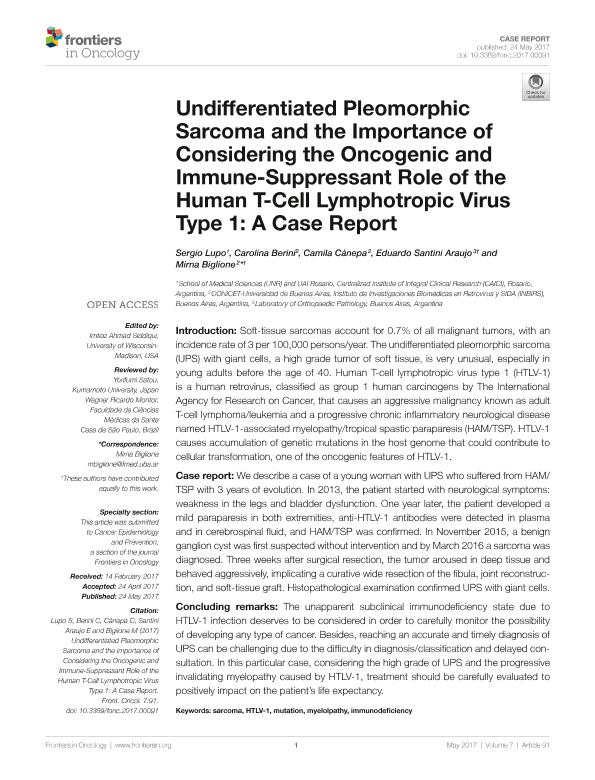Mostrar el registro sencillo del ítem
dc.contributor.author
Lupo, Sergio
dc.contributor.author
Berini, Carolina Andrea

dc.contributor.author
Cánepa, Camila

dc.contributor.author
Santini Araujo, Eduardo Héctor

dc.contributor.author
Biglione, Mirna Marcela

dc.date.available
2018-06-06T18:58:50Z
dc.date.issued
2017-05
dc.identifier.citation
Lupo, Sergio; Berini, Carolina Andrea; Cánepa, Camila; Santini Araujo, Eduardo Héctor; Biglione, Mirna Marcela; Undifferentiated Pleomorphic Sarcoma and the Importance of Considering the Oncogenic and Immune-Suppressant Role of the Human T-Cell Lymphotropic Virus Type 1: A Case Report; Frontiers; Frontiers in Oncology; 7; 5-2017; 1-5
dc.identifier.issn
2234-943X
dc.identifier.uri
http://hdl.handle.net/11336/47530
dc.description.abstract
Introduction: Soft-tissue sarcomas account for 0.7 % of all malignant tumors, with an incidence rate of 3 per 100,000 persons/year. The Undifferentiated Pleomorphic Sarcoma (UPS) with giant cells, a high grade tumor of soft tissue, is very unusual, especially in young adults before the age of 40. Human T-cell lymphotropic virus type-1 (HTLV-1) is a human retrovirus, classified as group 1 human carcinogens by The International Agency for Research on Cancer (IARC), that causes an aggressive malignancy known as adult T-cell lymphoma/leukemia (ATLL) and a progressive chronic inflammatory neurological disease named HTLV-1 associated myelopathy/ tropical spastic paraparesis (HAM/TSP). HTLV-1 causes accumulation of genetic mutations in the host genome that could contribute to cellular transformation, one of the oncogenic features of HTLV-1.Case report: We describe a case of a young woman with UPS who suffered from HAM/TSP with 3 years of evolution. In 2013, the patient started with neurological symptoms: weakness in the legs and bladder dysfunction. One year later, the patient developed a mild paraparesis in both extremities, anti-HTLV-1 antibodies were detected in plasma and in cerebrospinal fluid (CSF), and HAM/TSP was confirmed. In November 2015, a benign ganglion cyst was firstly suspected without intervention and by March 2016 a sarcoma was diagnosed. Three weeks after surgical resection, the tumor aroused in deep tissue and behaved aggressively, implicating a curative wide resection of the fibula, joint reconstruction and soft tissue graft. Histopathological examination confirmed UPS with giant cells.Concluding remarks: The unapparent subclinical immunodeficiency state due to HTLV-1 infection deserves to be considered in order to carefully monitor the possibility of developing any type of cancer. Besides, reaching an accurate and timely diagnosis of UPS can be challenging due to the difficulty in diagnosis/classification and delayed consultation. In this particularly case, considering the high grade of UPS and the progressive invalidating myelopathy caused by HTLV-1, treatment should be carefully evaluated to positively impact on the patient´s life expectancy.
dc.format
application/pdf
dc.language.iso
eng
dc.publisher
Frontiers
dc.rights
info:eu-repo/semantics/openAccess
dc.rights.uri
https://creativecommons.org/licenses/by-nc-sa/2.5/ar/
dc.subject
Sarcoma
dc.subject
Htlv
dc.subject
Ham/Tsp
dc.subject
Oncology
dc.subject.classification
Salud Ocupacional

dc.subject.classification
Ciencias de la Salud

dc.subject.classification
CIENCIAS MÉDICAS Y DE LA SALUD

dc.title
Undifferentiated Pleomorphic Sarcoma and the Importance of Considering the Oncogenic and Immune-Suppressant Role of the Human T-Cell Lymphotropic Virus Type 1: A Case Report
dc.type
info:eu-repo/semantics/article
dc.type
info:ar-repo/semantics/artículo
dc.type
info:eu-repo/semantics/publishedVersion
dc.date.updated
2018-06-06T13:45:47Z
dc.journal.volume
7
dc.journal.pagination
1-5
dc.journal.pais
Suiza

dc.journal.ciudad
Lausanne
dc.description.fil
Fil: Lupo, Sergio. Universidad Nacional de Rosario; Argentina
dc.description.fil
Fil: Berini, Carolina Andrea. Consejo Nacional de Investigaciones Científicas y Técnicas. Oficina de Coordinación Administrativa Houssay. Instituto de Investigaciones Biomédicas en Retrovirus y Sida. Universidad de Buenos Aires. Facultad de Medicina. Instituto de Investigaciones Biomédicas en Retrovirus y Sida; Argentina
dc.description.fil
Fil: Cánepa, Camila. Consejo Nacional de Investigaciones Científicas y Técnicas. Oficina de Coordinación Administrativa Houssay. Instituto de Investigaciones Biomédicas en Retrovirus y Sida. Universidad de Buenos Aires. Facultad de Medicina. Instituto de Investigaciones Biomédicas en Retrovirus y Sida; Argentina
dc.description.fil
Fil: Santini Araujo, Eduardo Héctor. Laboratorio de Patología Ortopédica; Argentina
dc.description.fil
Fil: Biglione, Mirna Marcela. Consejo Nacional de Investigaciones Científicas y Técnicas. Oficina de Coordinación Administrativa Houssay. Instituto de Investigaciones Biomédicas en Retrovirus y Sida. Universidad de Buenos Aires. Facultad de Medicina. Instituto de Investigaciones Biomédicas en Retrovirus y Sida; Argentina
dc.journal.title
Frontiers in Oncology
dc.relation.alternativeid
info:eu-repo/semantics/altIdentifier/doi/https://dx.doi.org/10.3389/fonc.2017.00091
dc.relation.alternativeid
info:eu-repo/semantics/altIdentifier/url/https://www.frontiersin.org/articles/10.3389/fonc.2017.00091/full
Archivos asociados
